Étiquette : femelle
On the origins of Modern Art, the problem of Symbolism


“At the turn of this century, painting is in bad shape. And for those who love the fatherland of paintings, very soon there will only remain the closed spaces of museums, in the same way there remains parcs for the amateurs of nature, to cultivate the nostalgia of that what doesn’t exist any longer…”
Jean Clair, Harvard graduate, director of the Musée Picasso
and of the centenary of the Venice Biennale of Contemporary Art in 1995.
Karel Vereycken, April 1998
Something is fairly rotten in the kingdom of Art, and if today (1998), finally some kind of debate breaks out, it is, halas, for quite bad reasons. Since it is uniquely in the context of budget cuts imposed on Europe by the Maastricht treaty that some questions are raised to challenge public opinion on a question carefully avoided till now: can we go on indefinitely subsidizing “modern artistic creation”, or what pretends to be so, with the tax-payers money, without any demand and outside any criteria?
Abusively legitimated by its status as a victim of the totalitarian regimes of Hitler, Stalin and Mao, Modern Art’s value as an act of resistance to totalitarianism watered away with the collapse of these regimes.
While we oppose the current budgetary cuts, since it would finish off the sick patient, we nevertheless propose to examine truthfully the illness and the potential remedies to be administered.
In France, the slightest critique immediately provoked the traditional hysterical fits. Raising a question, formulating an interrogation or even simply expressing a doubt on the holiness of Modern Art continues to be considered tantamount to starting an Inquisition. Even well integrated critiques such as the « left » leaning author Jean Baudrillard, or the director of the Paris Picasso museum Jean Clair and even the modern painter Ben, immediately bombarded by acid counter-attacks from the french and international Art nomenclature, accusing them of being “reactionaries”, “obscurantist” and, to crown it all, of being “fascists”, “nazis” and even “anti-Semites”.
For seasoned observers these attacks remind the simplicity of Stalinist rhetoric: “Anybody discussing the revolution is a fascist”. Modernist musical composer Pierre Boulez even accused a journalist of being a “Vichy collaborator” because unconvinced of the utility of the computers of his musical research foundation IRCAM.
That spark of debate, if any, became rapidly poisoned by the possessive defense of the scarce budget allocations. Why all this noise? Jean Clair already exposed his views fourteen years ago in his book “Considérations sur l’Etat des Beaux-Arts, Critique de la Modernité” (1983) without provoking such a hullabaloo.
But in times of crisis, funds seem to provoke more passion than fundamentals. In any case, we welcome Clair’s courage. His ironical critique of the rampant snobbism of the tiny, incestuous world of contemporary Art makers is totally uncompromising. His defense of the necessary rebirth of the basic skills of drawing and pastel is on the mark.
Clair rightly makes a distinction between « Contemporary » art on one side and « Modern » art on the other side. Contemporary Art, broke with Modern Art from the point it became a systemic apology of “non-sense [absence of meaning] that was elected a system. » Reality, writes Clair, leads him to demand that we return to “meaning” (deliberately banned by « contempory » art) which was the very power of « Modern » Art.
To understand this difference, inspired by the insights and works of my friend, american art historian Michael Gibson, we shall document here that the birth of « Modern » art was nothing but a mutation from figaritive « Symbolism » to non-figurative (abstract) Symbolism, both accepting their role of expressing a symbolic meaning. « Contemporary art », profiting from the confusion of the idea of a « secret » meaning inherent in symbolic artistry, then sneaked in and tried to pretend that any sort of meaning should and could be eliminated from artistic expression.
QUESTION:
« So if I understood you correctly, you claim there exist criteria that are universal, enabling rational man to distinguish with reason between beauty and ugliness which would free art from the arbitrary caprices of taste?”
ANSWER:
« Uh, yes, and even if one cannot establish a catalogue filled with models and instructions enforceable till the end of all times, we firmly think there exists a way of looking at things, a mental attitude which we can prove to have been fruitful since the early cave paintings, as those of Chauvet in southern France dating from 50.000 years B.C., till today. »
To say it differently, there is no such thing as the aesthetics of form, but some kind of aesthetics of the soul.
Any attempt to frame aesthetics, as a set of formal rules of the visible forms is the shortest road to finish in a sterile academic dead end.
By analogy, we could say that such an attempt in the domain of language would make linguistics the science of poetry…
Leonardo da Vinci defined the mission of the painter as the one who has to « make visible the invisible ». So it is up to us to define the aesthetics of the invisible and how they manifest themselves in the visible realm.
How to represent the world
Let’s look at ways of representing phenomena by starting from what appears to be the « most simple ».
A. “Bounded objects” of an inorganic or organic nature: for example stones, a glass bottle, but also a flower or the body of an animal or a man. Their relative finiteness makes their representation easier. But to “make them alive”, one has to show their participation to something infinite: the infinite variations of the color or a stone, the numerous reflections of light shattered by the glass bottle, the relative infinite number of leaves of a tree, the huge number of successive gestures which dictate spirit and life to the bodies of living beings. As you can see now, these so-called “simple” phenomena oblige us to choose, beyond simple sense perception, perceptions that enable us to express the idea of the object rather than its mere form.
B. “Openly unbounded objects”: for example a wave of the ocean, a forest, the clouds in the sky, or the expression of the eyes of a human being. Even more than in A., the Chinese principle of the “li” has to be considered. Instead of imitating their exterior form, and since their sometimes turbulent shapes escape in any case from our limited sense-perceptions, the exterior form has to be regarded as the expression of the idea that was the generating principle and we have to concentrate on choosing elements in the visible realm that indicate that “higher reality”. That makes the difference between the portrait of a living being and the portrait of a wax model…
C. “Ideas free from an object”: for example Love, Justice, Fidelity, Laziness, Cold, etc. How can we build gangways to the visible capable of representing these “higher ideas”?
ANSWER:
- Instead of representing the idea, I can try to substitute it with the object of the idea (one of Plato’s favorite subjects). For example I can try to represent the idea of Love by representing a woman. However, she cannot be but the object or the subject of love (She is loved or loves), but she is not Love itself.
- Since I’m in trouble having a representation in the visible realm of an idea of a “superior” nature, I decide to designate it by symbol. For example, a little heart to symbolize Love. For a Martian visiting Earth in the context of interplanetary tourism, the little heart has no meaning. By logical deduction, he could arrive at the conclusion the heart indicates heart patients, or cardiologists or eventually the designed victims of an Aztec sacrificial cult. In order to understand what is involved, some earthling has to initiate him into the pre-convened meaning of the symbol to which the inhabitants of earth agreed to. If not, it might take some time before he understands the “secret” meaning of the symbol.
- That symbol can be a simple visible element but also a little story we call allegorical. Illustrating an allegory will always remain a simple didactical exercise far underneath the sublime mission of art.
- The notion of a parable, as those one finds in the Bible, brings us closer to the wanted solution by its metaphorical character (Meta-poros in Greek meaning: that which carries beyond). The isochronical presence of several paradoxes, provoking surprise and irony by the ambiguities of the painting shakes up the sense certainty of our empirical perceptions that darken so much our natural predisposition for beauty.
SYMBOL and METAPHOR, What’s the difference?
Symbol: designates a thing
Metaphor: carries beyond the thing
Symbol: its only value is expressed by itself
Metaphor: its only value is given to it by implicit analogy.
Symbol: its secret meaning can only be learnt by convention
Metaphor: its meaning can be discovered by sovereign cognition.
Rembrandt’s Saskia
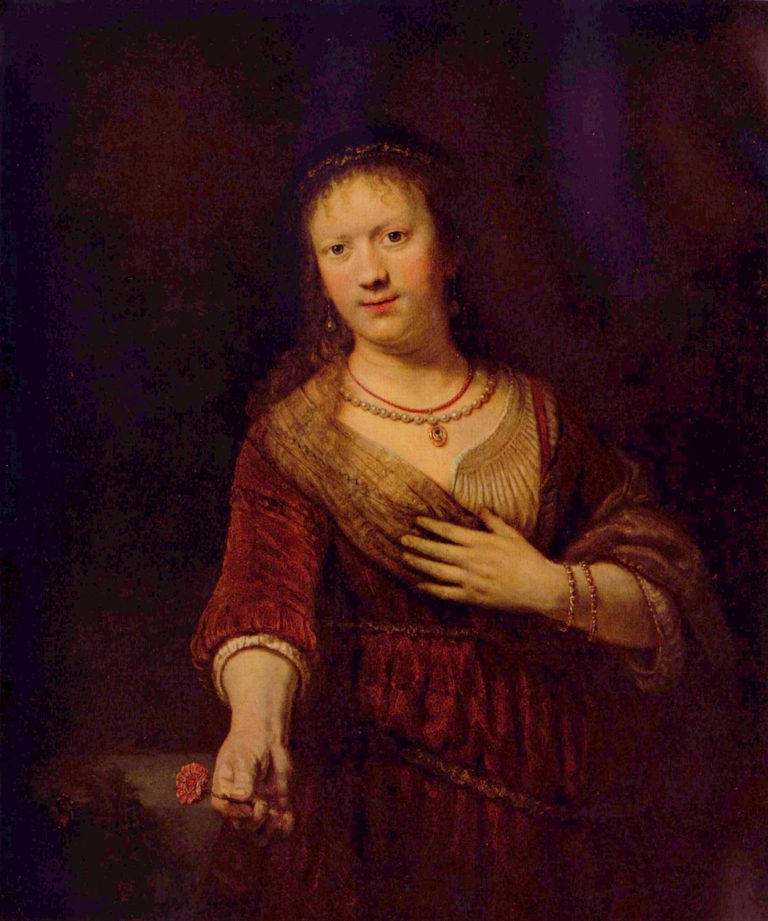
Let us examine together Rembrandt’s painting “Saskia as Flora” (1641), where she offers a flower to the viewer. Is this a portrait of Rembrandt’s wife along with the portrait of a flower? Or is there a new concept involved that arises in our mind as a result of this juxtaposition that could be called Love or Fidelity (to you I offer my beauty, as I offer you this flower…) The putting into visual analogy of two quite different things make appear a third one, which is in fact the real subject.
The easiest example of a real metaphorical paradox can be seen at work in wordplay or a cartoon drawing. For example if I draw a young couple in love and replace the head of the young man with the head of a dog, a completely different meaning is given to the image. The viewer, intrigued by the love relationship is surprised by the possessive (or submissive) character suggested by the dog head. Variations of the type of dog and his expression will vary the very meaning of the image. Once again, it is by the use of an implicit analogy that an unexpected arrangement gives us the means to grapple an idea beyond the object represented.
The little light bulb that goes on in our heads when we solve a metaphorical paradox gives us a threefold happiness. First the joy to think, since our thought process is precisely based on that unique process. Second to live in harmony with our world, which being a creative process itself “condemns” us to be free. And finally the joy that derives from the sharing of that happiness of discovery with other human beings who get even more creative in turn. Hence, every scientific or artistic discovery becomes a ray of light enlightening the path for humanity to go. The glowing enders of yesterday give us the fire to illuminate tomorrow.
But to do so, one cannot represent in a formal way the solution found. One is obliged to recreate the context which obliges the viewer to walk the same road we did till the precise point where he discovers himself the poetical concept.
The science of enigmas of Leonardo da Vinci

Renaissance genius Leonardo da Vinci was a specialist of this kind of « organized » enigmas, conspiracies to have us think. Let’s have a look at his painting “Saint John the Baptist”, his last painting and somehow his last will resuming all the best science of his creative mind. The ambiguous character of the person has been often used as “proof” of Leonardo’s alleged homosexuality.
One can indeed ask the question if represented here we see a man or a woman? The strong muscles of the arms plead for male while the gracious face argues for female. Desperate, our mind asks if this is devil or angel? While one finger points to heaven, similar to Raphael’s Plato in the « School of Athens », the other hand rests on the heart, and in the same time a coquette smile meets intelligent eyes…
Of course, Saint-John the Baptist, patron saint of Florence served as the symbol of a humanist Platonic current that realized the fact that the « little lights » of classical Greece announced the coming of the « great light » of Christianity.
Scholastical Catholicism of those days pretended that anybody living before Christ could be nothing more than a pagan. So what about Saint John the Baptist? The compositional method here employed is not of a symbolical nature, but that of paradoxical metaphor, i.e. build by enigmas that guide us, if we accept the challenge, to reflect in a philosophical way about the nature of mankind: how is it possible we are finite in some parts and infinite in others? That we are mind, life and matter? Of divine and human nature?
That is in some words what we mean by the method of paradoxical metaphors, the only method which gives sense to the word « classic », since conceived in a universal way for all men in the time of all times.
The opposite approach is the symbolist one, officially named after an artistic current that swept over Europe at the end of the XIXth century.
Together with impressionism that capitulated to positivism, symbolism was the mother of Modern Art and its bastard son Contemporary Art.
The symbol, erected as a method of artistic expression, is characteristic of a society that is incapable of change. It celebrates the banishing of the movement of progress but masks that self-denial with the never-ending multiplication of images and objects, always equal to themselves. Symbolism is nothing but the transformation into an object of a strong emotion or a mystical thought. The increase of its effect through incantation, fetishism, repetition, etc., agitating the symbol for its magical value as such, evokes the same obsessive fixation as pornography. As the American thinker Lyndon LaRouche ironically underscored the point:
“the difference between Beethoven (method of metaphor) and Wagner (method of symbolism) is defined by the level at which emotions are provoked in the audience. In the case of Beethoven, the beauty evoked brings us to tears. In the case of Wagner, it is the chairs that get wet…”
From there on, as we will document in due course, the arising of “Modern Art” reveals itself to be nothing more than a mere linear transposition of “figurative” symbolism to “abstract” symbolism.
These terms are obviously empty shells, since all figuration is figurative, and all figuration is the expression of what could be called an “abstract” concept or idea, conscious or not.
So, contrary to Contemporary Art, whose aggressive meaning is that nothing has, can or has the right to have any meaning, Modern Art claims to possess a sense of meaning, but that meaning is mystical-symbolical and hermetic by nature. We are not saying that symbols should be banned from Art, but we cannot but underline that symbolistical though as a compositional method is incompatible with Art’s nature.
Real Art concentrates on communicating a unique human quality, the Sublime, that expresses freedom and not that of a man enslaved either to his sentiments neither to his principles.
Contemporary Art, as all large scale swindles, needs quite some rhetoric and literature to convince it’s public of its pure absolute relativity. It is said that each of us sees it differently; that we all possess our own criteria and that formulating any judgment is by itself already an act of a totalitarian fascist in germ. It is somehow like the thief who accuses his victim of cupidity and lack of brotherly love when the victim refuses to hand over his purse. But if one claims the right to create something without meaning, one equally revindicates the right to no critique, and therefore ends any form of real debate beyond « it gives me a kick » or « no kick ».
That Art, when it is sincere, by claiming it cannot be apprehended by human cognition, defines itself as egoistical and asocial. It cannot but harvest what it sows: indifference.
Before entering two personalities considered being the godfathers of Modern Art, Wassily Kandinsky (1866-1944) and Piet Mondrian (1872-1944), it is necessary to situate the historical context in which they operated. Then we will investigate a high level political operation: the Theosophical Society whose malefic theories exerted great influence on both godfathers of Modern Art.
Symbolism, the final stage of Romanticism
To crush the republican spirit that emerged at the end of the eighteenth century, which saw the American and French revolution, the European oligarchy deployed initially Napoleon Bonaparte.
Then, on the ruins of the Napoleonic wars, they promoted the iron corset of the Holy Alliance and the impotent ideology of regretting: the privilege of the suffering heart. Romanticism, often described as a “movement for the liberation of the me, as a reaction against the regularity of classicism and the rationality of the preceding centuries” became the official culture of the Restoration before being adopted by the Monarchy of July.
Even the talented French poet Baudelaire, prisoner of the zeitgeist stated shamelessly: “What is there more absurd than progress?” or, premonitory:
“Who says romanticism says Modern Art, i.e. intimacy, spirituality, color, aspiration towards the infinite”.
In a way this was the expression of a certain revolt against positivism, a “scientific” materialism which some tried to impose top down and for which the hearts of men were not mobilized.
We are light-years away from the “science for all” approach which radiated Gaspard Monge at the early Ecole Polytechnique, or Lazare Carnot’s “Ode to enthusiasm”. It was the same Holy alliance that forced Carnot into exile and outrooted Monge´s influence at the Ecole, crushing France’s scientific and industrial progress.
In 1871, Louis Pasteur, in a beautiful article “Why France did not find a superior man in the moment of peril” analyzed the dramatic events of those days.
But also Germany was living under a real cultural dictatorship. Prince Metternich, by the Carlsbad decrees forbade any representation of Friedrich Schiller‘s theatre plays. Also, the “sulfurous” poet Heinrich Heine, mocking the Salons of Mme de Stael and all the other nostalgics of the lost glory of the past, became the permanent target of the Holy Alliance’s police operations.
Francesco Goya, who strongly lambasted the massacres of Bonaparte’s Spanish expedition (1810-1814) in his series “The disasters of War”, characterized this particular historic moment in his engraving “The sleep of Reason generates monsters”.
The Great Upheaval
On the economic front, it was only after Abraham Lincoln defeated the British backed pro-slavery Confederacy and the then ensuing industrial buildup (1861-1876), that a little progress was tolerated in Europe.
The oligarchy had to solve the following paradox: How can we counterbalance the rising American power while in the same time prevent the emergence of Republics in Europe, inspired by the American System, on the ruins of the European empires?
What some have called the « Great Upheaval » was nothing less than a profound transformation of daily life in Europe. It was precisely at that time that the Symbolist current got so dominant.
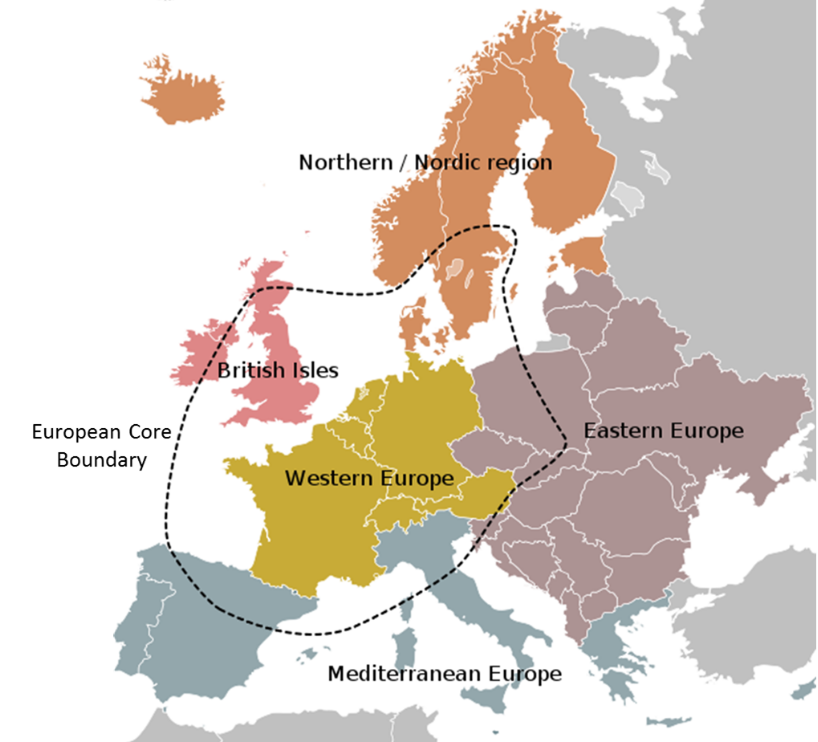
In the “industrial polygon of the Europe of steam” which connected Glasgow, Stockholm, Gdansk, Lodz, Trieste, Florence and Barcelona, it is estimated that of 7 persons from the country side, 1 stayed working the land, another went to the new world or the colonies, and the remaining 5 went working in the cities. The same estimate says that close to 60 million people left Europe. One can imagine the cultural choc for those who quit the magical world of pastoral backwardness.
In that sense, Symbolism was also a means for the oligarchy to deprive these incoming populations from the benefits of urban culture by keeping them in a state of irrationality.
The fear of political takeover by sovereign Nation-States dedicated to industrial and scientific progress was so great that the British Prime Minister, Lord Palmerston (1784-1865), activated through his agent Guiseppe Mazzini (1805-1872), the “Young Europe” movement, uniting most revolutionary currents of those days. Under the auspices of the Foreign Office’s Arab Bureau, the east saw the sudden birth of a whole series of Arab countries, eventually localized on this or that oilfield.
The Theosophical Society
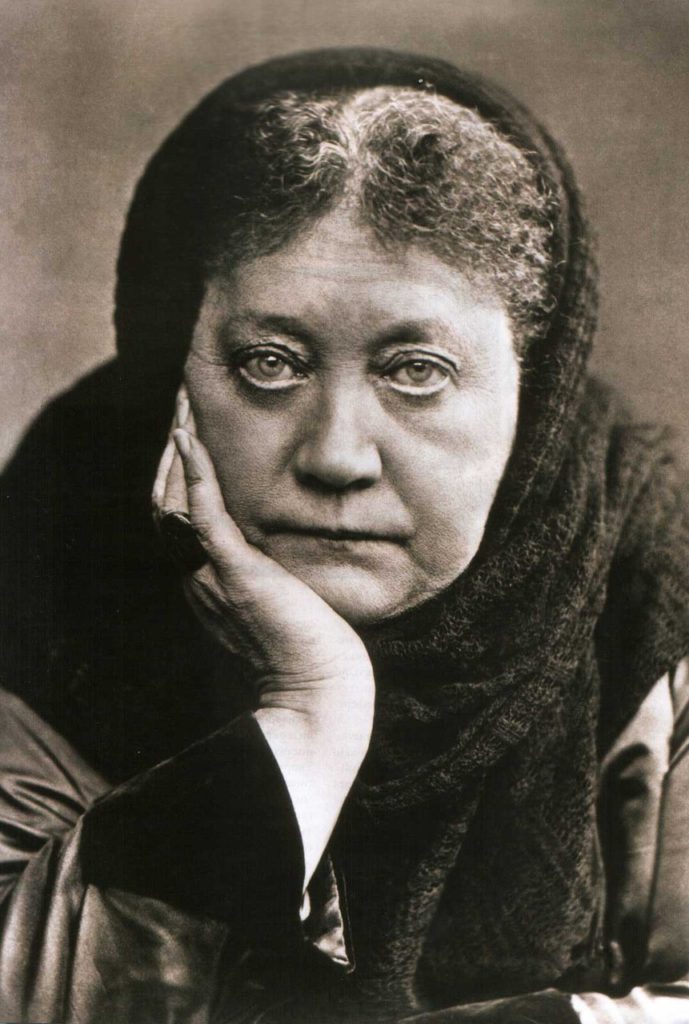
It is in that context that one has to situate the extraordinary offensive of the Theosophical Society (TS), one of these pseudo-religions rising out of the esoterical swamp of the second half of the nineteenth century. It is useful to zoom in on the life of Helena Petrowna Blavatsky (HPB) (1831-1891), the main front figure of the TS.
Granddaughter of the Prussian General Alexis von Rottenstern-Hahn, HPB was born in 1831 in Ukraine.
At the age of sixteen, her parents married her to an old General with the name of Nicéphore Blavatsky, vice-governor ofprovince of Erivan, which she quitted nearly immediately.
In 1848, she meets a Copt with the name of Paulos Metamon and as early as 1851 she turns up in London, where she meets the “spiritualists” and meets the “revolutionary” Mazzini. In 1856 she affiliates with the Young Europe’s Carbonarist association.
Then, she travels across different continents having become a toy in the hands of her British promoters which she refers to as her “Spiritual masters”, as she called one of her controlling agents “Master Morya”.
As soon as 1851 she travels to the US and Mexico, crossing Texas and Louisiana. After numerous trips in the Caucasus, Syria and Lebanon, we find her on November 3, 1867, riding a horse siding Garibaldi. Severely wounded at the battle of Mentana, she’s left for dead.
While recuperating in Paris, she meets a journalist with the name of Michal, and the founder of French spiritism, Allan Kardec. The former claim they discovered and developed HPB’s faculties as a medium. Deployed in that capacity to Cairo, and in the USA, she’s accused of being a fraudster. It is relevant to situate Edgar Allan Poe’s literary production as the effort of the pro American system faction to ridicule the British offensive in favor of esoteric irrationality.
Colonel Henry Steel Olcott
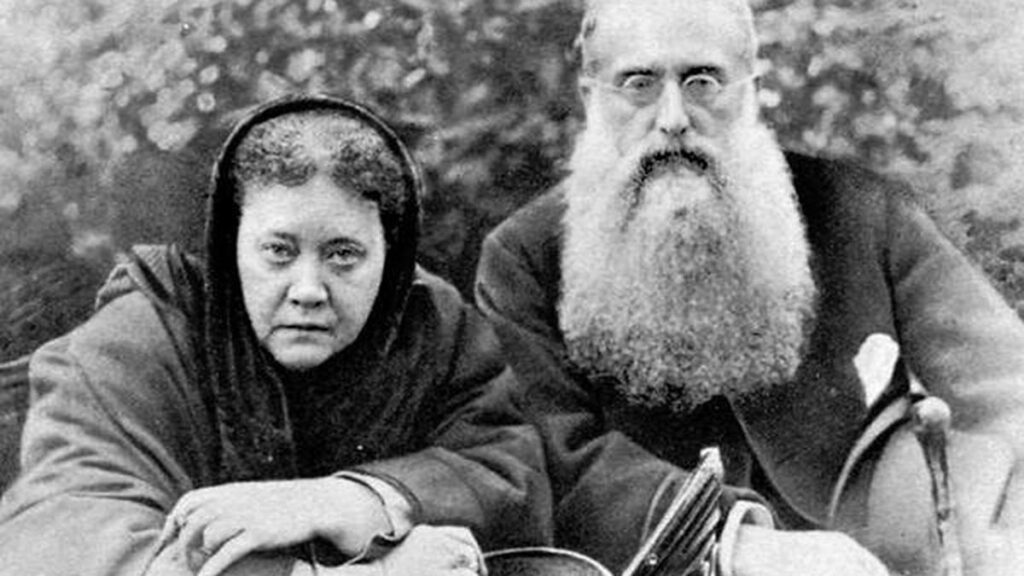
Around 1874, Blavatsky receives the order to enter into contact with a lawyer and insurance expert: Henry Steel Olcott.
Former officer of the Military Police, he became colonel during the civil war and shared his life in between Masonic lodges and spiritism. Active as a journalist, he was in charge of covering paranormal phenomena for the New York Sun and the New York Graphic.

Olcott got many inroads into the American esoterical scene of those days: John King, William Stainton Moses, Leadbeater, the Miracle Club of Philadelphia and a secret society called The Hermetic Brotherhood of Luxor whose members signed their writings with a swastika, symbol of the divinity of Tibet, the immense mountain plateau where supposedly the Aryan race found refuge at the time of the great deluge…
Then, on October 20, 1875 was founded in New York a “Society for Spiritualist investigations”. Its president was Olcott; the two vice-presidents were Felt and Pancoast, while Blavatsky figured as a mere secretary. Without willing to downplay her personal role, it looks she was brought in more for propagandistical reasons than in regard of her proper leadership qualities. As prominent members one can mention William Q. Judge and Charles Sotheran, both high dignitaries of Anglo-American masonry.

It is also remarkable that the Confederate General Albert Pike, Grand Master of the Scottish Rite of the Southern district based in Charleston, and one of the founders of the Ku Klux Klan met Blavatsky in those days, but seems to have dropped her, considering her to low level. Pike’s spiritual reputation is largely overdone and he has been accused of having extensively plagiarized the French occultist Elipha Levi.
Less than a month later, on November 17, 1875, the Society’s named was changed into “Theosophical Society”. Olcott and Blavatsky immediately started a great project to conquer the minds of India.
Officially, they pretended to establish “The Great Contact”, a bridge between the initiated of the East with those of the West and to fusion them together.
HPB gets without any difficulty the American nationality while Olcott obtains from the president of the United States, Rutherford Hayes, a handwritten clearance, a document requesting American diplomats all over the world to provide them their aid. Also, the US Secretary of State provided Olcott a diplomatic passport, something relatively rare for a non-career diplomat. When they reached ground in India, all this American help will give them the means to establish the “British Theosophical Society” (sic).
The British oligarchy seemed to have preferred Hinduism and its great toleration of the cast system where individuals’ desires for a better life are hoped for in the next one, as a preferential partner for the British oligarchy and its imperial class society.
The fundamental choice of the cultural matrix that defines the particular beliefs, transcending any particular form of regime, has always been the “secret weapon” guaranteeing the survival of the oligarchical system. In this way, it is not any longer necessary to police people’s minds on issues, since you control the underlying axioms shaping their thought process itself.
What the Theosophical Society claims today in regard to its role in the birth of a national consciousness of India is an ugly lie, and maybe without Theosophy India might have gained independence a century earlier!
While it is true that Gandhi, who encountered the TS in a vegetarian club in London, studied their works, he never really adopted their convictions. After having started the TS in India, Olcott, in the same geopolitical strategy, will explore Buddhism going through Asia and settle in Japan to wake up the “sleeping masses”.
Olcott composed a Buddhist catechism, created a multicolor Buddhist flag and a General Committee of Buddhist Affairs that functioned as a kind of Vatican for Buddhism. He also held an extraordinary conference in Japan’s military center, Hiroshima. There he distributes swastikas to the audience to which he predicts the coming of terrible wars will strike humanity and that Hiroshima will become one of the symbols for peace and fraternity in the world (sic)!
Swipe Christianity of the Earth!
Olcott and Blavatsky seemed to be quite effective in performing funny magical tricks. Some of them were described by one of their victims, Mme de Jelihowsky:
- Clear and direct answers, of telepathic nature.
- Formulas pronounced in Latin, by way of hits, for remedies which resulted always in healing.
- Divulgation in public of secrets concerning persons that were present but that hurted Blavatsky by their doubts.
- Change of the weight of furniture or persons at will.
- Letters written by unknown correspondents with a writing that was not hers. Often, when somebody asked a question she would say: go in your room, and in such or such a place you will find a letter answering your question.
- Appearance and disappearance of objects without a plausible explanation.
- Faculty to let music be heard at will, wherever and whenever desired.
When depressed, Blavatsky admitted she swindled her admirers.
In their magazine, “The Blue Lotus”, Olcott wrote on November 27, 1895, p. 418:
“Certain days, she was in such a state of mind that she denied the powers by which she had given us carefully controlled demonstrations and pretended to have deceived her public”.
Behind all this cheap mumbo-jumbo reserved for the naïve members of the TS, there was small initiated elite aware of their real geo-strategical imperialism of the mind.
“Our aim”, said Blavatsky, in line with British geopolitics, “is not to restore Hinduism, but to swipe Christianity of the Earth”.
After the cremation of Baron of Palm, a rich donator of the TS, the first one in the history of the United States against which over three thousand people demonstrated, and who’s only aim was to introduce Hinduism to the U.S. population, Olcott and HPB exposed confusedly their doctrine in 1878 in “Isis unveiled”, a 1300 pages book that she called “the work of her life”, available in a more popular version under the name of “The Secret Doctrine”.
From the standpoint of Theosophy (which some called Theosophistry), and in a pure remake of manicheanism, religious beliefs could be classified between male and female religions.
The latter gave preponderance to peace, tranquility, sensuality, fertility and adaptation to the environment, while the male religions gave extensive privilege to the spirit of conquest and undertaking, to proselytism and to the superiority of male virtues.
Of course, Abraham and Moses, founders of the great monotheistic religions in which man does not adapt but intervenes and even discovers his specific harmony by transforming nature and highering its order, were targeted as the animal to be hunted. It was indeed these religions that largely overruled the ancient cult of mother goddess Gaia that became the Isis cult.
Isis cult

ISIS
Isis is the most illustrious of the Egyptian goddesses, in charge of the home, marriage and fertility. Her power spread throughout the universe after she discovered the secret name of the supreme God, Ra.
She embodied the feminine principle, the magical source of all transformation, and was considered by all esotericists to be the Initiatrix, the one who held the secret of life, death and resurrection.
According to legend, she put back together her husband Osiris, whom the serpent Set had cut into fourteen pieces and scattered across Egypt. Only one piece was missing: the penis. Isis made one in silver. Her marriage to Osiris gave birth to Horus, who triumphed in the battle against the evil spirit, Set, but Isis asked him to spare her in order to maintain the cosmic battle between good and evil…
Often designated by the annealed cross, symbol of millions of years of future life, which is confused with the « Isis knot », symbol of immortality, Isis is also represented by the Ouroboros, or the snake that bites its own tail: sexual union with oneself, permanent self-fertilization, perpetual transformation from death to life.
To dominate the battlefield of the mind, a Machiavellian strategy was conceived:
1. Since the adoration of the mother goddess and the practice of female virtues nearly remained exclusively existent in India and Tibet, archaic Hinduism had to be revived. That is the reason why the Theosophists ran to India in order to prevent the nearby extinction of Hinduism. In France, Blavatsky’s main sponsor in that effort was the wealthy Duchesse de Pomar, a Spanish aristocrat descending from the Marquis of Northampton. For that aim, Orientalism and the practice of Yoga had to be encouraged and popularized.
2. Since the TS on its own was too tiny to weaken Christianity, Judaism and Islam, the TS combined its efforts with anti-progress Fabian Socialism. The just battle for republican secularism, founded on the mutual respect of religious freedom was distorted into a virulent denunciation of the Judeo-Christian philosophical outlook. The socialist inspiration of Jean Jaurès, while criticizing the inherent materialism of financial capitalism and Marxism passionately defended, in the name of a sense of transcendence, the right of entire growth and the pursuit of happiness for every human individual.
3. To fight “male supremacy”, it was decided by speech and action to defend anything that supposedly opposed it. Defend universal peace, to fight for the end of sexual discrimination, to make women free from their body, to make love become stronger than violence. For that reason, the TS always took a woman as its front figure. Annie Besant, an attractive Irish protestant and a member of the Fabian Society took the leadership of the TS after having directed the “Malthusian League” of England in 1877.
Such a project obviously didn’t rally much enthusiasm in those days, especially not in Catholic countries. The opposition was so strong that the TS adapted its outlook into some form of esoteric Christianity designed to penetrate the Christian strata. But for HPB, Judeo-Christian monotheism remained nothing else but a barbaric schism of Buddhism:
“What some called with despise paganism was the ancient wisdom full of divinity; and Judaism with its offshoots, Christianity and Islam took all their inspiration of their ethnic father…”
According to HPB, Jesus the Essenian was persecuted by the Jews because “the Essenian were converts, Buddhist missionaries that had come to Egypt, Greece and even Judea”
So, for her, Christianity had to be “de-judaizised” to make it again compatible with the female principle. The basic postulate behind all this was her fascination for the Aryan civilization whose symbol, the Swastika, of notorious nazi reputation, figures still today in the emblem of the ST.

THE SWASTIKA
A widespread symbol in all ancient civilizations (Asia, Central America, Mongolia, India, Northern Europe, Celts, Basques, Etruscans, etc.), it represents the vortex of creation.
The swastika, which often replaces the wheel, is made of a cross, each branch of which is quadrupled, as in vectorial orientations that define a gyratory direction and then return to the center. Its numerical value is therefore four times four = sixteen. This is the powerful development of reality or the Universe, an expression of extreme secular power. Its appropriation by Hitler was no accident.
The rise of the Nazi movement has been associated with the rise of the famous Thule Society, another esoteric society in the theosophical style, in which we find Karl Haushofer, Adolf Hitler’s real master thinker.
The anthroposophists of Rudolf Steiner, a great admirer of Nietzsche and the eugenicist Haeckel, are a dissident branch of the Theosophical Society, omnipresent today among the German « Grünen » (Greens).
The Nabis (the Prophets)
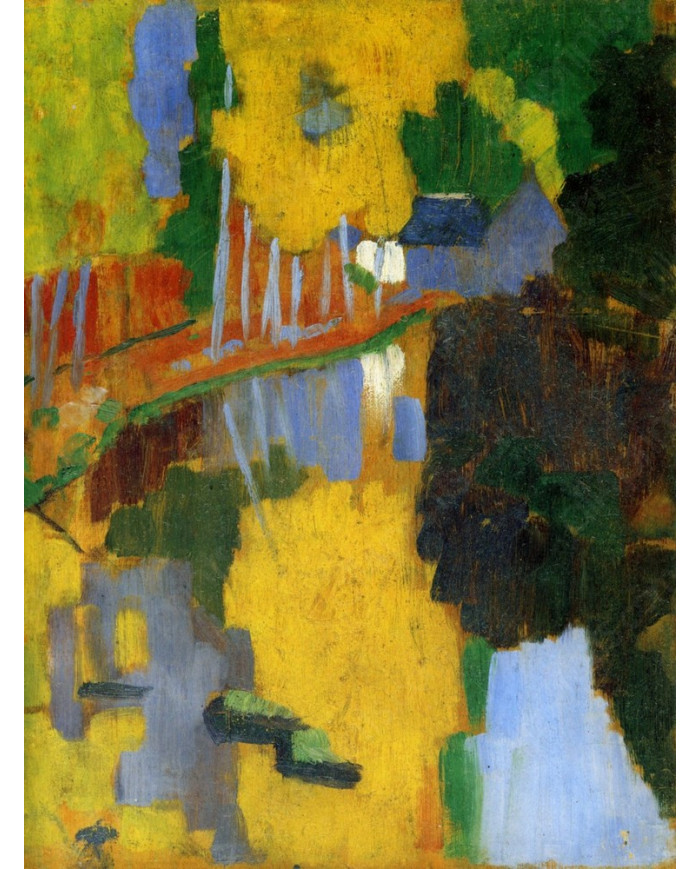
That gives us some elements to situate the historical context into which arrived Modern Art. Esotericism was so much an invading fashion that many painters tried to explore pre-Christian religions to discover “forgotten symbols”.
That was certainly the case of the French symbolist Gustave Moreau when he painted the Gnostic myth of Jupiter and Sémélé. His pupils were the “moderns” Henri Matisse, Georges Rouault and Albert Marquet.
Another young symbolist, Emile Bernard inspired Gauguin, which in turn inspired Paul Sérusier.
Art historian Michael Gibson keenly pointed out the fact that a great number of the founding figures of Modern Art (Kandinsky, Mondrian, Malevitch, Picasso, etc.) have ALL been figurative symbolists at their start.
We are convinced they remained so, but that they deconstructed, i.e. downscaled, the complexity of their symbolic language to more primitive elements of the visual field (a color, a line, a number, a geometry, etc.).
Gibson accurately identified the precise moment of that historical turning point towards modernism with the shift provoked by the group of the “Nabis”.
In 1888, close to Pont-Aven in Brittany France, Paul Sérusier painted one day in the presence of Gauguin a landscape composed of vibrating primitive flat surfaces of colors on the top of his box of cigars.
That work was nicknamed “The Talisman” by his comrades who considered it a revelation of a new approach in painting, the absolute destruction of any reference to physical space by the use of light or perspective. Welcome to the mystical flat space of color and its “interior light”.
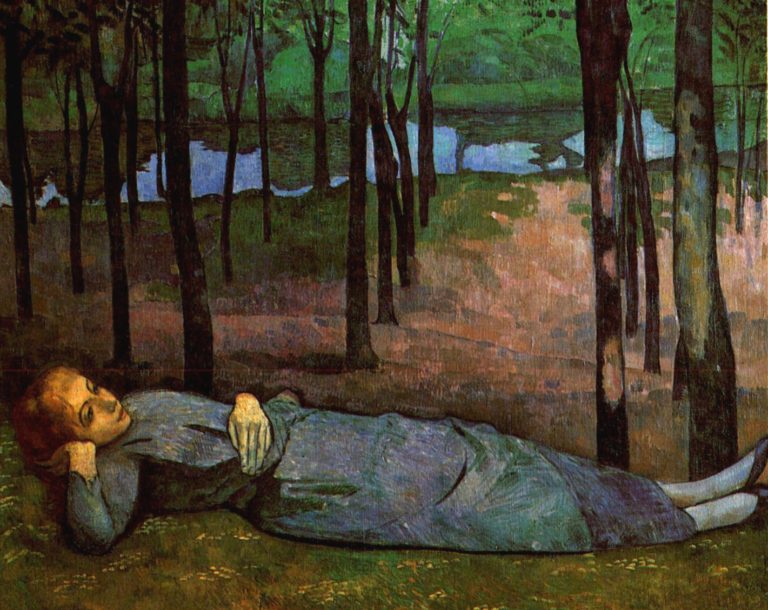
Paul Sérusier, Emile Bernard, Paul Gauguin and some friends rapidly called themselves the “Nabis”, which meant prophets in Hebrew.
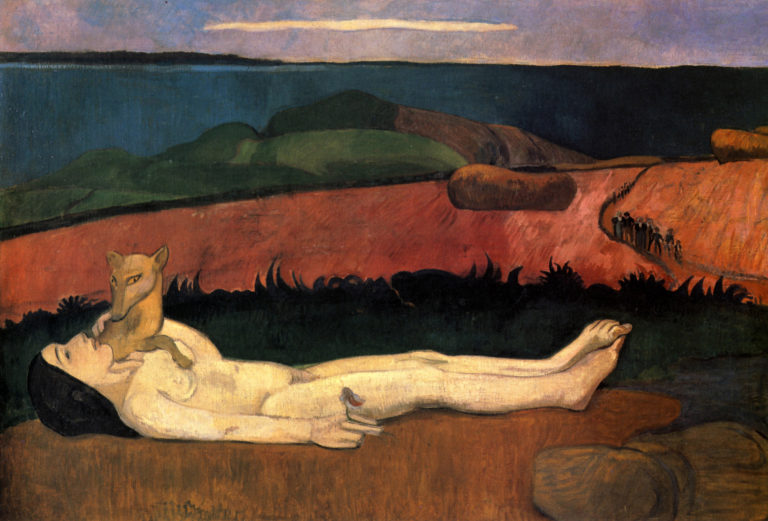
They regularly met in a house they called “The Temple” on 22, Boulevard Montparnasse in Paris. The phrasing alone already indicates the messianic mindset of these converts. Hoaxer Sar Joséphin Péladan united in 1892 all these young talents to the Salon of the Rosicrucians.
In the « Amendments of the Esthetical Rosicrucians », Peladan explicitly prescribed history painting, the painting of patriotic or military scenes and also,
« any representation of contemporary life, portraits, rustic scenes, seascapes, oriental scenes, domestic animals, flowers, fruits, accessories and other exercises painters insolently dare to expose ».
On the contrary « and to privilege the ideal of Catholicism and mysticism, the Rosicrucian order will welcome any work founded on legend, myth, allegory, dream, etc. »
One sees here, how Catholicism, as much as its opponents, if stripped from its content and reduced to its bare symbols could coexist peacefully with these insanities.
One ends up wondering why a World War didn’t break out earlier with elites espousing such follies! And when it did break out in 1914, Jacques Emile Blanche declared,
« Very often during this chemical and scientific ‘cubist’ war, in the night damaged by the air raids, I dreamt about Stravinsky’s Sacre du Printemps ».
Peladan’s Salon brought together symbolists from Belgium, Holland, Germany, such as Ferdinand Hodler, Carlos Swabe, Jan Toorop, Ferdinand Knopff, Jean Delville, Georges Minne and Xavier Mellery, with « Nabis » like Emile Bernard, Félix Valloton and Charles Fillinger.
A great part of this came into France from across the Channel where a real revolt was going on against the Academicism of Sir Joshua Reynolds.
Under the auspices and protection of the very popular John Ruskin, a real nostalgic fanatic willing to bring humanity back to a pre-Renaissance mystical feudal order, appeared the Pre-Raphaelite Brotherhood, the PRB, that one of it’s degenerate founders, Dante Gabriel Rosetta, with sincere self irony called « Penis Rather Better »...
Kandinsky: from positivism to mysticism

The life path of the Russian painter Wassily Kandinsky, universally identified as the official godfather of Modern Art, gives us even more insight in the subject matter.
Kandinsky was born on December 4, 1866 amidst a wealthy orthodox family of aristocrats that made it as tea merchants. As Henri Matisse, he enters the University to study law and political economy.
In 1889 he’s sent on a mission by the Imperial Society of Natural Sciences and Ethnography to study the criminal law of the Finish community, the syrjaenen, a non-christianized tribe living in the province of Vologda, five hundred kilometers north of Moscow.
Kandinsky admitted in 1937:
« To be honest, the origin of my abstract painting has to be looked for in the popular Russian painting which I discovered for the first time during my trip to Northern Russia. »
Obtaining the post of law professor in 1896, another event that takes place the same year will completely “blow” his mind and decide him to quit his academic career entering a profound
mystical crisis.
That event was the discovery of radioactivity by the French physician Antoine-Henri Becquerel:
« For me, the disintegration of the atom, was the same thing as the disintegration of the entire world. The most solid walls suddenly collapsed. Everything became precarious, unstable and floppy. I wouldn’t any longer be astonished to see a stone melt in the air in front of me and become invisible. Science seemed to be annihilated: its most solid bases were a delusion, an error of scientists who were not building in a transfigurated light their work with a solid hand stone by stone, but grappling in the darkness. There, looking for truths by chance, and in their blindness, they confounded one object for the other. »
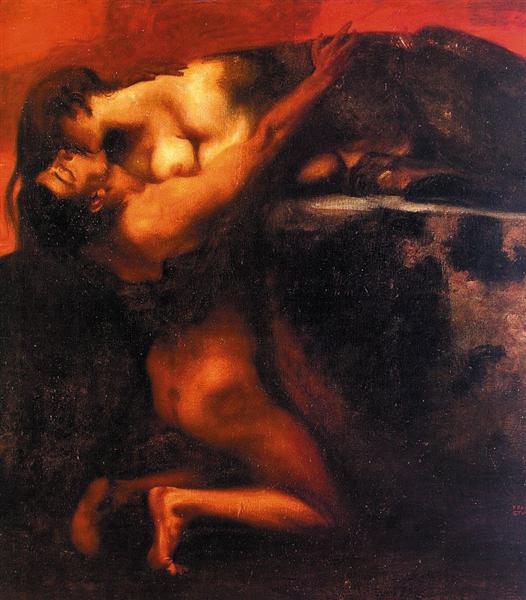
Kandinsky’s transition from “materialistic positivism” to “mystical spiritualism” is a clinical study case of the point we want to demonstrate.
Ecstatic after the discovery of a Wagner opera performance in Moscow, he leaves Russia to go live in Munich. He gives the following description of that experience:
« Lohengrin seemed a perfect realization of Moscow. The violins, the profound bases and particularly the wind instruments personify for me the splendid power of the twilight hours. »
In 1900, after a first refusal, he is admitted, together with Paul Klee, to enter the Academy of Franz von Stück, a well-referenced symbolist of Munich.
Von Stück’s painting, the « Kiss of the Sphinx » takes up the same theme as Moreau’s « Jupiter and Sémélé. » Attracted by (female) beauty, man in reality embraces death (a woman), a remake of the classical Eros/Thanatos theme.
Der Blaue Reiter to defeat materialism
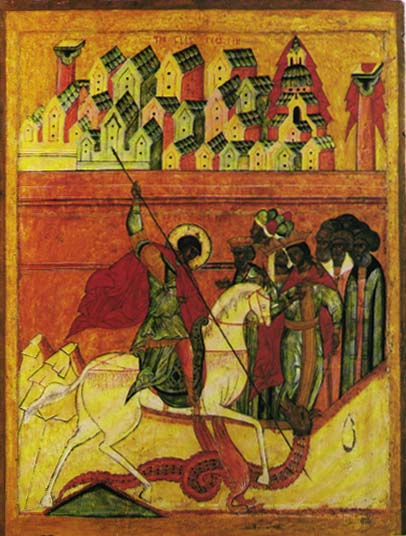
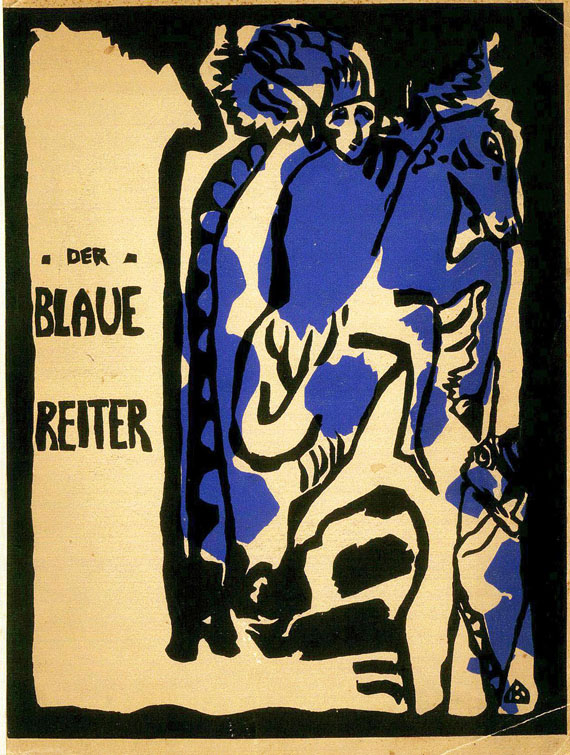
One year later, the pupil becomes himself a teacher and creates the group “Phalanx”, symbol of the fight against Academicism.
Kandinsky reveals himself as an able organizer of art exhibits, throwing in his personal fortune and capable of convincing other sponsors.
Very rapidly he gives the exhibits an international dimension and the presence of foreign artists reinforces the illusion that the new tendency in art possesses a universal character. In the theosophist tradition, he rightly opens his academy to women, excluded till then from art academies!
His admiration for Blavatsky is limitless.
« Blavatsky was certainly the first to establish, after living for years in India, a solid link between these so-called « savages » and our culture. At that point, there came into being one of the greatest spiritual movements uniting a great number of people, materializing that union under the form of a « Theosophical Society ». That society is composed of lodges, who try to approach the questions of the spirit by the way of interior knowledge. »
Uniting the group of « Die Brücke » with his own efforts and those of Franz Marc and Paul Klee, he called into being the almanac of the “Blaue Reiter” (Blue Cavalier), in reality a reworked image of a Byzantine icon of Saint-Georges defeating the dragon of evil transposed into a bleu cavalier defeating materialism.
In his ground text of 1909, Concerning Spiritual in Art and painting in particular, Kandinsky builds up a theoretical system where every color possesses its own separate identity:
« Red, as one imagines oneself, as a color without border, typically warm, acts interiorly as a very living color, vivid and agitated, which does not possess the thoughtless character or yellow that gets dispersed to all sides, but gives the effect, despite all its energy and intensity, of the powerful note of immense force nearly conscious of its aim.
« There is in that effervescence and that eagerness, principally in itself and scarcely turned towards the exterior, some sort of male maturity. »
« When it is medium, as cinnabar, the red gets more permanent and increases its sharp sensibility: it is like a passion that burns with regularity, a force certain of itself, which is not easy to overlay, but which can be extinguished by the blue as red iron by water. That red tolerates nothing cold that makes it lose its resonance and its meaning. Or more exactly, that tragic, brutal cooling down produces a tone that painters, especially today, avoid and outlaw as « dirty ». They are wrong. Dirt, through its material form, represents materially, as a material being, possesses its interior resonance as any other material being. That why the attempt to avoid dirtiness in painting is as unjust and arbitrary as yesterday’s fear in front of « pure » color.
« One does not have to forget that all the means derived from the interior necessity are pure. Said differently, that what is dirty from the outside is pure from the inside. If not, what is pure from the outside is dirty inside. »
« The six colors, who, by couples, form three major contrasts, present themselves to us as a great circle, as a snake which bites its tail (symbol of infinity and eternity). And on the right and on the left we find the two great possibilities for silence; the one of death and the one of birth. »
One sees here the splendid rigor of a law professor, charmed by the “sense of construction of Roman law”, applying his science zealously to mysticism. Kandinsky’s writings are always inhabited with references to music, such as resonance, harmony, rhythm, etc.
In the same way musical ideas got freed of the presence of text and words, Kandinsky and argue that the same thing can be done in the visual domain using merely color, rhythm, form, etc. taken as entities on themselves.
But what music is he talking about, beneath Wagner? In Kandinsky’s immediate entourage we find the atonal composer Arnold Schönberg, who exploded the well-tempered system according to the same mystical principles, making it as such incapable of transmitting ideas.
From Mondrian to Breker
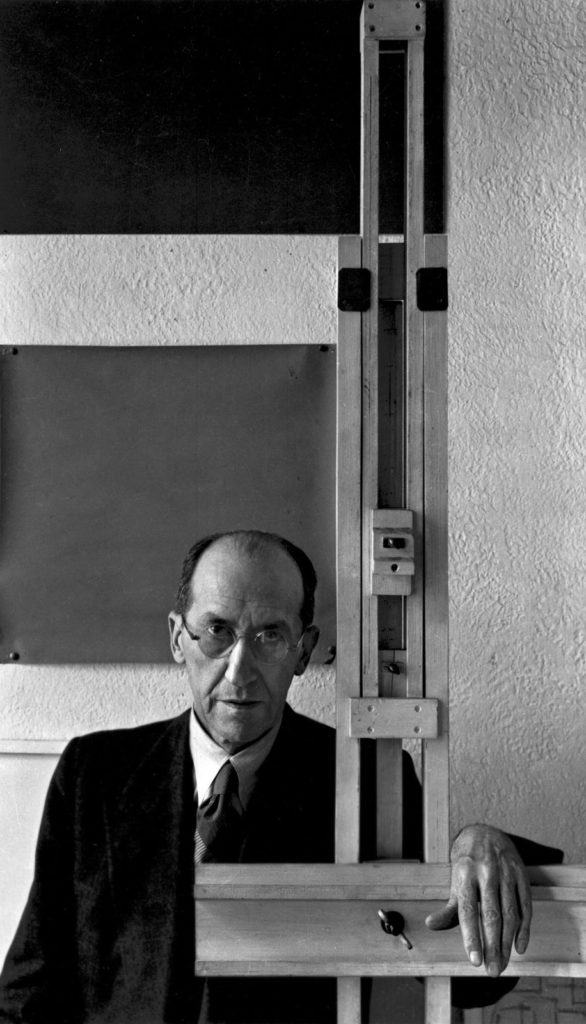
The famous Dutch cubist, Piet Mondrian, was another original product resulting from the mixture of Theosophy and Calvinist rigorism.
At that time, the TS launched a recruitment drive calling on those desiring to “have a place amidst the pioneers of the coming thinking”.
The unique picture decorating the wall of Mondrian’s studio in Laren was a large picture of Blavatsky. The artist was in frequent discussion with the Dutch theosophist writer Schoenmakers whose books Mondrian was distributing.
In 1892, he starts studying Theosophy and joins the TS in 1909.
His triptych, “Evolution” expresses the three stages of spiritual evolution: on the left, the mother goddess with triangles pointing down, the lowest level. In the middle, a female figure, with triangles pointing up, stage of activity and awakening. On the right the synthesis of both, the crossing triangles forming a David star.
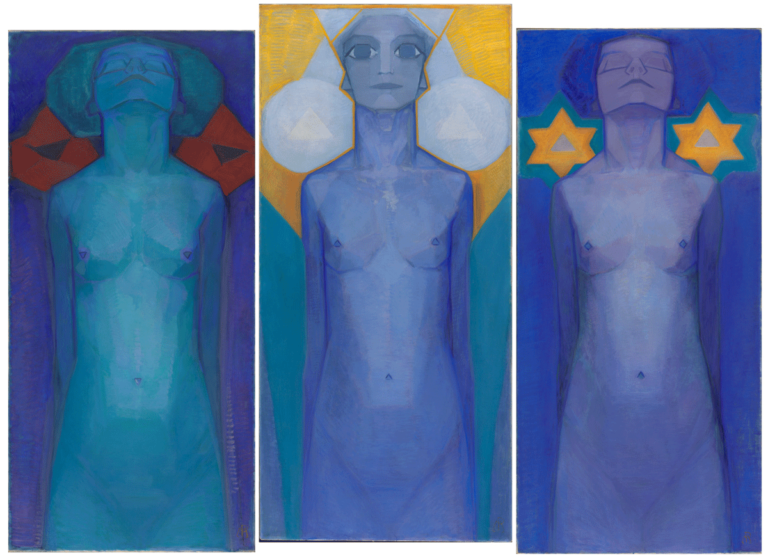
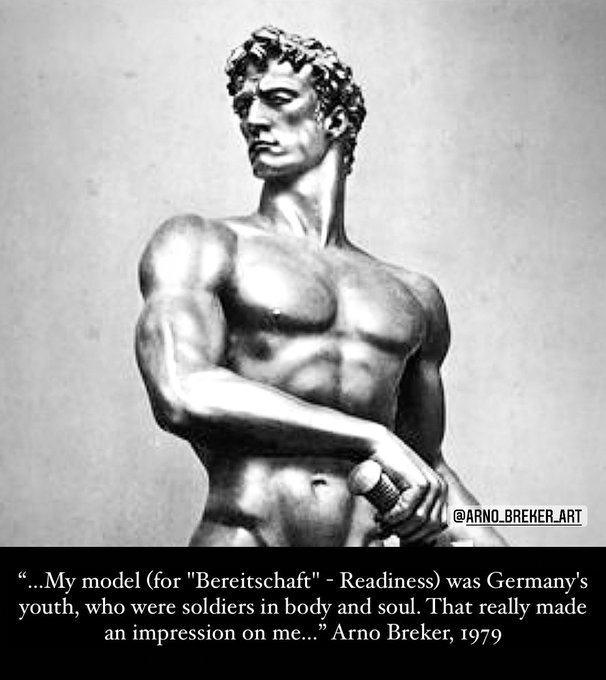
Let us not forget talking about the official art of the Third Reich, with the figurative symbolism of the outright pagan sculptor Arno Breker.
Breker was Hitler’s personal pet sculptor and realized in 1936 the infamous incarnations of the Ubermensch (superior man) for the Nazi’s Olympic Stadium in Berlin.
As proven by interviews after the war, the so-called “apolitical” Breker was very well aware for what kind of power he was working.
His work “Bereitschaft” (readiness) of 1939 proves the case.
Mascot of the Parisian elites, since trained by a Frenchman, his personal exhibit at the Orangerie in Paris in 1942 drew over 80.000 visitors. He shared the fascist ethics of filmmaker Leni Riefenstahl, always ready to popularize nazi symbology.
Breker was befriended with Jean Cocteau, Vlaminck and Derain, and turned down Stalin’s offer to work for the USSR after the war.
A cubist in his early days (1922), he was disappointed by the meeting he had with Paul Klee and the Bauhaus, and invested himself in the total deification of the human body. Breker confirmed: “I always tried to give a meaning with symbols”.
In all his spirituality, Breker did not hesitate in his “Vision of Europe” to transpose an eagle’s heads on human bodies, making them into Horus, son of Isis.

The inversion of these symbolisms, restating the supremacy of male values over female values was nothing less than the creation of esthetics of war.
In 1980, Breker explained in an interview how he saved the life of Picasso and that of Aristide Maillol’s Jewish companion, Dina Vierny using his direct position as an intimate of Adolph Hitler.
The Italian futurists are another obscene example. Many proudly joined the fascist movements and some were really chocked Hitler condemned their modernism at a Nuremberg rally.
Marinetti, who published his “Futurist Manifesto” in Le Figaro in 1909 claimed proudly:
« Point 3: Literature being up till now an apology of contemplating immobility, ecstasy and sleep, we want to exalt the aggressive movement, the fevery insomnia, the gymnastic step, the dangerous jump, the slap in the face and the punching.
« Point 7: There is no beauty outside struggle. There are no masterpieces without aggressive character. Poetry must be a violent assault on unknown forces, to summate them to lie down before man…
« Point 9: We want to glorify war –the unique hygiene of the world, militarism, and patriotism, the destructive gesture of the anarchists, the nice ideas that kill, and the disdain of women…
« Point 10: We want to demolish the Museums and Libraries, fight moralism, feminism and all of opportunistic and utilitarian cowardness. »
As we have demonstrated, this modernism is nothing less than the restoration of the most backward values of ancient civilizations, deprived of their dynamic and reduced to caricatures of their worst defaults.
What we defend here is on the contrary a Renaissance, that is a universal but authentic process of artistic creation fertilized by the best contributions of all cultures, be them Indian, African, Asiatic, American or European.
Our critique of Modernism is not based on any nostalgic longing for a supposedly perfect Golden Age that is no more, but on the commitment to valorize mans dignity and mind.
If you really want to use the word modern, talk about the Mummy portraits of the Fayoum of the second and third century after DC.
Theosophy today
Even if there still exists today an international network of Blavatsky lodges from Antwerp to Philadelphia or Saint Petersburg, it has been in the recent days mainly the radical green current who is leading the fight to destroy the humanist cultural paradigm.
As the Theosophists yesterday, the Greens which have replaced the mother goddess (sounds too religious) with Mother earth (Gaia) express the same messianic zeal in their commitment to sweep the earth and often rally de facto the forces of race, soil and blood.
As yesterday, the green current gets supported by the highest spheres of Anglo-American aristocratic gangsterism.
Deceased financial angel of French archconservative Philippe de Villiers, Jimmy Goldsmith, has a brother, Teddy, who happens to be one of the main funders of Greenpeace!
Documents and articles consulted:
- Chaitkin, Anton, Tarpley, Webster, The Palmerston Zoo, Executive Intelligence Review, Vol. 21, nr.16, Apr.15, 1994.
- Cheminade, Jacques, Time to destroy the myth of Napoleon Bonaparte, Executive Intelligence Review, Vol. 23, 42, Oct.18, 1996.
- Clair, Jean, Considérations sur l’Etat des Beaux Arts – Critique de la Modernité, Gallimard, Paris 1983.
- Gibson, Michael, Le Symbolisme, Editions Taschen, Paris, 1994.
- Kandinsky, Nina, Kandinsky et moi, Flammarion, Paris 1978.
- Kandinsky, Wassily, Concerning the Spiritual in Art, and painting in particular, Dover Editions, New York, 1977.
- Lantier, Jacques, La Théosophie, Editions Culture, Art, Loisirs, Paris.
- LaRouche, Lyndon, How Cauchy ruined France, EIR, Vol.24, nr. 24, June 20, 1997.
- Noël, Bernard, Arno Breker et l’Art officiel, Jacques Damase Editeur, Paris 1981.
- Prampolino, Enrico, Stile Futuristica, nr. 3, Turin 1933.
- Parmelin, Hélène, Peinture, pierre de touche de la liberté, L’Unité nr. 416, 1978.